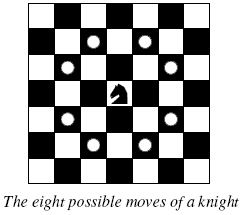Description
 Background
Background
The knight is getting bored of seeing the same black and white squares again and again and has decided to make a journey
around the world. Whenever a knight moves, it is two squares in one direction and one square perpendicular to this. The world of a knight is the chessboard he is living on. Our knight lives on a chessboard that has a smaller area than a regular 8 * 8 board, but it is still rectangular. Can you help this adventurous knight to make travel plans?
Problem
Find a path such that the knight visits every square once. The knight can start and end on any square of the board.
Input
The input begins with a positive integer n in the first line. The following lines contain n test cases. Each test case consists of a single line with two positive integers p and q, such that 1 <= p * q <= 26. This represents a p * q chessboard, where p describes how many different square numbers 1, . . . , p exist, q describes how many different square letters exist. These are the first q letters of the Latin alphabet: A, . . .
Output
The output for every scenario begins with a line containing "Scenario #i:", where i is the number of the scenario starting at 1. Then print a single line containing the lexicographically first path that visits all squares of the chessboard with knight moves followed by an empty line. The path should be given on a single line by concatenating the names of the visited squares. Each square name consists of a capital letter followed by a number.
If no such path exist, you should output impossible on a single line.
If no such path exist, you should output impossible on a single line.
Sample Input
3 1 1 2 3 4 3
Sample Output
Scenario #1: A1 Scenario #2: impossible Scenario #3: A1B3C1A2B4C2A3B1C3A4B2C4
国际象棋中马的走法,比较棘手的是题目要求输出路径,并且是按照字典序,故需要从第一个格开始。
AC代码:
#include "iostream"
#include "cstdio"
#include "cstring"
#include "algorithm"
using namespace std;
struct node
{
/* data */
int row;
char col;
};
int p, q, x, y;
bool map['Z' + 1][27];
void path(int i, int j, int num)
{
switch(num) {
case 1: {
x = i - 1;
y = j - 2;
break;
}
case 2: {
x = i + 1;
y = j - 2;
break;
}
case 3: {
x = i - 2;
y = j - 1;
break;
}
case 4: {
x = i + 2;
y = j - 1;
break;
}
case 5: {
x = i - 2;
y = j + 1;
break;
}
case 6: {
x = i + 2;
y = j + 1;
break;
}
case 7: {
x = i - 1;
y = j + 2;
break;
}
case 8: {
x = i + 1;
y = j + 2;
}
}
}
bool dfs(node* a, int i, int j, int step)
{
map[i][j] = true;
a[step].row = i;
a[step].col = j;
if(step == a[0].row) return true;
for(int k = 1; k <= 8; ++k) {
path(i, j, k);
int ii = x, jj = y;
if(!map[ii][jj] && ii >= 1 && ii <= p && jj >= 'A' && jj <= 'A' + q - 1)
if(dfs(a, ii, jj, step + 1)) return true;
}
map[i][j] = false;
return false;
}
int main(int argc, char const *argv[])
{
int n;
cin >> n;
int t = 1;
while(t <= n) {
memset(map, false, sizeof(map));
cin >> p >> q;
if(p == 1 && q == 1) {
cout << "Scenario #" << t++ << ":" << endl;
cout << "A1" << endl << endl;
continue;
}
node a[p * q + 1];
a[0].row = p * q;
bool flag = false;
for(int j = 'A'; j <= 'A' + q - 1; ++j) {
for(int i = 1; i <= p; ++i)
if(dfs(a, i, j, 1)) {
cout << "Scenario #" << t++ << ":" << endl;
for(int k = 1; k <= a[0].row; ++k)
cout << a[k].col << a[k].row;
cout << endl << endl;
flag = true;
break;
}
if(flag) break;
}
if(!flag) {
cout << "Scenario #" << t++ << ":" << endl;
cout << "impossible" << endl << endl;
}
}
return 0;
}























 1617
1617

 被折叠的 条评论
为什么被折叠?
被折叠的 条评论
为什么被折叠?








